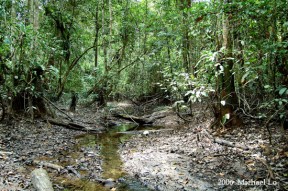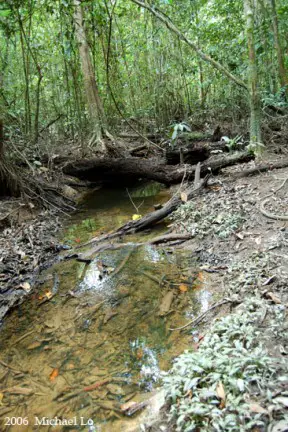Nemacheilus spiniferus
SynonymsTop ↑
Noemacheilus spiniferus Kottelat, 1984
Etymology
Nemacheilus: from the Greek nēma, meaning ‘thread’ or ‘filament’ and cheilos, meaning ‘lip’ in reference to the furrowed lip in members of this genus.
Classification
Order: Cypriniformes Family: Nemacheilidae
Distribution
Has been recorded throughout much of the Malaysian state of Sarawak, plus the Kapuas River system in the Indonesian province of Kalimantan Barat (West Kalimantan) and the Malinau River drainage, Kalimantan Timur) (East Kalimantan) province, Borneo.
Type locality is ‘Sungai Liam, tributary of Baram River, Sarawak state, Borneo, East Malaysia’.
In Borneo there also exist records from the upper Belait River, southwestern Brunei Darussalam, while populations also inhabit the Natuna and Anambas island archipelagos, Riau Islands province, Indonesia.
Habitat
Most commonly found in shallow (<1 m deep), flowing stretches of forest streams with substrates of sand, gravel, small rocks and organic detritus. The water is generally clear to slightly tannin-stained and aquatic plants usually limited to the odd patch of Cryptocoryne spp. though riparian vegetation often grows thickly.
The water in such habitats is typified by low mineral hardness and pH, and sympatric species include Nemacheilus kapuasensis, N. saravacensis, Kottelatlimia pristes, Pangio semicincta, P. shelfordii, Mystus castaneus, and Silurichthys marmoratus.
At the type locality of Homaloptera batek (Tan, 2009) N. spiniferus was collected from a foothill stream running swiftly over a rocky/gravel substrate with clear water of pH 6.4. Other fish species included Garra borneensis, Paracrossocheilus vittata, Rasbora elegans, Homaloptera orthogoniata and Homalopteroides stephensoni plus unidentified species of Hypergastromyzon, Gastromyzon, and Glyptothorax.
In the upper Belait River, Brunei it was found living alongside an unidentified Osteochilus sp., ‘Puntius‘ johorensis, Rasbora caudimaculata, R. einthovenii, Hemirhamphodon kuekenthali, Phenacostethus smithi, Nandus nebulosus, and Osphronemus septemfasciatus.
Maximum Standard Length
45 – 55 mm.
Aquarium SizeTop ↑
An aquarium with a base measuring 60 ∗ 30 cm or more is recommended.
Maintenance
Not difficult to maintain under the correct conditions; we strongly recommend keeping it in a tank designed to resemble a flowing stream or river with a substrate of variably-sized rocks, sand, fine gravel, and some water-worn boulders.
This can be further furnished with driftwood branches arranged to form a network of nooks, crannies, and shaded spots, thus providing broken lines of sight. While the majority of aquatic plants will fail to thrive in such surroundings hardy types such as Microsorum, Bolbitis, or Anubias spp. can be grown attached to the décor.
Though torrent-like conditions are unnecessary it does best if there is a high proportion of dissolved oxygen and some water movement in the tank meaning power filter(s), additional powerhead(s), or airstone(s) should be employed as necessary.
Like many fishes that naturally inhabit running water it’s intolerant to accumulation of organic pollutants and requires spotless water in order to thrive, meaning weekly water changes of 30-50% tank volume should be considered routine.
Water Conditions
Temperature: 23 – 26 °C
pH: 5.0 – 7.0
Hardness: 0 – 143 ppm
Diet
Nemacheilus species are omnivorous although the bulk of their diet consists of small insects, worms, crustaceans and other zooplankton with only relatively small amounts of plant matter consumed, mostly via the stomach contents of prey items.
In the aquarium they will accept dried foods of a suitable size but should not be fed these exclusively. Daily meals of small live and frozen fare such as Daphnia, Artemia, bloodworm, etc., will result in the best colouration and condition.
Behaviour and CompatibilityTop ↑
Fishes which inhabit similar biotopes in nature constitute the best options, especially peaceful, open water-dwelling cyprinids since the presence of one or two schools can make a visible difference to the confidence of this naturally reclusive loach.
Other possibilities include rheophilic loaches from genera such as Gastromyzon, Pseudogastromyzon, Beaufortia, and Sewellia, plus benthic cyprinids like Crossocheilus and Garra species.
Some similarly-shaped relatives such as other Nemacheilus, Acanthocobitis, and Schistura spp. are excessively territorial or otherwise aggressive, although a combination may work in larger aquaria.
This species is peaceful with conspecifics and seems to appreciate being maintained in a group so the purchase of four or more specimens is highly recommended.
Sexual Dimorphism
Males possess a suborbital flap, and sexually mature specimens develop tubercules on the first three pectoral-fin rays.
Adult females are likely to be slightly larger and heavier-bodied than males.
Reproduction
Unrecorded.
NotesTop ↑
This species is rare in the aquarium hobby and may only have appeared as bycatch among shipments of other species to date.
It’s a member of the N. selangoricus group of species within the genus, an assemblage first recognised by Hadiaty and Kottelat (2009) and characterised by possession of two rows of horizontally-arranged, elongate scales on the caudal peduncle each with a tubercle at the posterior edge, which in some species is located at the tip of an acuminated process (long, tapering, posterior projection), plus body pattern consisting of dark, vertical bars. Other species presently included in this group are N. selangoricus, N. tebo and N. tuberigum.
N. spiniferus is most similar to N. selangoricus since it possesses acuminate scales above and below the lateral line on the caudal peduncle, a feature not shared with any other congener.
It can however be distinguished by the following characters: presence of 10-13 irregularly-shaped dark bars on flanks (vs. 8-12 very regular bars in N. selangoricus), slightly wider than the interspaces; dorsal head length 21-23 % SL (vs. 18-22 %); process of acuminate scales as long as (vs.shorter than) remainder of scale, it’s base width approximately ½ of scale width (vs. ¼-⅓).
The rows of elongated scales on the caudal peduncle in N. tebo and N. tuberigum are not acuminate and lack the posterior process, plus the black spot at the base of the anterior dorsal-fin rays and rows of similarly-coloured markings in the dorsal-fin seen in N. spiniferus and N. selangoricus are absent.
Following Kottelat (1990) the genus Nemacheilus is characterised by a combination of characters as follows: elongate body; complete lateral line; presence of enlarged scales above and below the lateral line in some species; caudal-fin forked to deeply forked with enlarged upper lobe; large eye; small, strongly arched mouth; lips usually thin; usually no median interruption in upper lip; upper jaw with processus dentiformis (a tooth-like projection); no median notch in lower jaw; long barbels; males usually with suborbital flap, pectoral-fin rays 2-6 thickened and with rows of tubercules.
The family Nemacheilidae is widely-distributed across most of Eurasia with the Indian subcontinent, Southeast Asia and China representing particular centres of species diversity.
References
- Kottelat, M., 1984 - Japanese Journal of Ichthyology 31(3): 225-260
Revision of the Indonesian and Malaysian loaches of the subfamily Noemacheilinae. - Bănărescu, P. M. and T. T. Nalbant, 1995 - Travaux du Museum d'Histoire Naturelle 'Grigore Antipa' 35: 429-495
A generical classification of Nemacheilinae with description of two new genera (Teleostei: Cypriniformes: Cobitidae). - Hadiaty, R. K. and M. Kottelat, 2009 - Raffles Bulletin of Zoology 57(1): 119-125
Nemacheilus tebo, a new loach from Sangkulirang Karst, East Kalimantan, Indonesia (Teleostei: Nemacheilidae). - Hadiaty, R. K. and M. Kottelat, 2010 - Zootaxa 2557: 39-48
Nemacheilus marang, a new loach (Teleostei: Nemacheilidae) from Sangkulirang karst, eastern Borneo. - Kottelat, M., 1990 - Verlag Dr. Friedrich Pfeil, München, Germany: 1-262
Indochinese nemacheilines. A revision of nemacheiline loaches (Pisces: Cypriniformes) of Thailand, Burma, Laos, Cambodia and southern Viet Nam. - Kottelat, M., 2012 - Raffles Bulletin of Zoology Supplement 26: 1-199
Conspectus cobitidum: an inventory of the loaches of the world (Teleostei: Cypriniformes: Cobitoidei). - Kottelat, M., 2013 - Raffles Bulletin of Zoology Supplement No. 27: 1-663
The fishes of the inland waters of southeast Asia: a catalogue and core bibiography of the fishes known to occur in freshwaters, mangroves and estuaries. - Kottelat, M. and E. Widjanarti, 2005 - Raffles Bulletin of Zoology Supplement 13: 139-173
The fishes of Danau Sentarum National Park and the Kapuas Lakes area, Kalimantan Barat, Indonesia. - Parenti, L. R. and A. L. Downing Meiser, 2003 - Brunei Museum Journal 10: 17-54
Fishes of the Belait River. - Parenti, L. R. and K. K. P. Lim, 2005 - Raffles Bulletin of Zoology Supplement 13: 175-208
Fishes of the Rajang Basin, Sarawak, Malaysia. - Tan, H. H. and K. K. P. Lim, 2004 - The Raffles Bulletin of Zoology Supplement 11: 107-115
Inland fishes from the Anambas and Natuna Islands, South China Sea, with description of a new species of Betta (Teleostei: Osphronemidae). - Tan, H. H. and M. Kottelat, 2009 - Ichthyological Exploration of Freshwaters 20(1): 13-69
The fishes of the Batang Hari drainage, Sumatra, with description of six new species. - Tang, Q., H. Liu, R. Mayden and B. Xiong, 2006 - Molecular Phylogenetics and Evolution 39(2): 347-357
Comparison of evolutionary rates in the mitochondrial DNA cytochrome b gene and control region and their implications for phylogeny of the Cobitoidea (Teleostei: Cypriniformes). - Šlechtová, V., J. Bohlena and H. H. Tan, 2007 - Molecular Phylogenetics and Evolution 44(3): 1358-1365
Families of Cobitoidea (Teleostei; Cypriniformes) as revealed from nuclear genetic data and the position of the mysterious genera Barbucca, Psilorhynchus, Serpenticobitis and Vaillantella.





